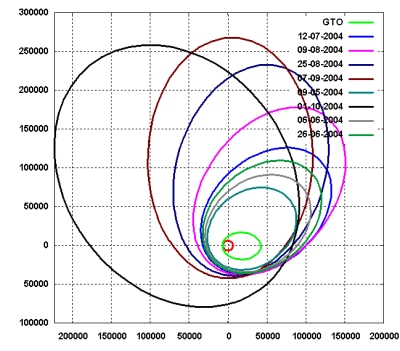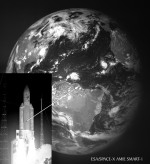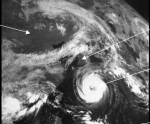No. 29 - SMART-1 First Birthday in Space and Second Lunar Resonance
As anticipated, SMART-1 has had its second encounter with the Moon. The event took place 15 September at 01:07 UTC, when SMART-1 was at apogee and about 280 000 km from the Earth. As was the case with the first lunar resonance, the Moon's gravity has substantially altered the SMART-1 orbit as can be clearly seen in the figure below. Up to 1 October, at the 278th engine pulse, the SMART-1 electric propulsion system has cumulated a total ON time of nearly 3440 hours, consumed about 54 kg of Xenon and imparted to the spacecraft a velocity increment of about 2570 ms-1.
Science update
AMIE
D-CIXS
On 27 September an attempt was made to monitor X-rays from an Earth aurora with D-CXIS, starting at 02:17:00 UTC. The experiment lasted a little over three and half hours. The detectors of DCIXS were oriented in such a way that they could monitor both magnetic poles of the Earth at the same time in case an aurora would occur over one of them. The data were downloaded to Earth and the D-CIXS team at Rutherford Appleton Laboratory in the UK is presently processing them.
Laser Link
Also on 27 September a Laser Link experiment was performed to study the laser beam propagation through the atmosphere and space. A laser was switched on from the Optical Ground Station in Tenerife and the spacecraft performed parallel scans of 1.325 degrees. At the same time AMIE took images to allow the team to observe the line produced by the laser hit while the spacecraft was slowly moving (0.013 degrees per second and later 0.026 degrees per second).
Future Activities
The third resonance and last encounter before the lunar capture will take place on 12 October, when the orbital period of SMART-1 and the Moon will be at a 1:3 ratio. The last time SMART-1 will approach the Earth, the last perigee, will be on 2 November. Finally, the last part of the Earth orbit will lead to the capture by the Moon and the first perilune on 15 November:
| Third lunar resonance | 12 Oct 2004, 03:18 UTC |
| Last Earth approach / perigee | 02 Nov 2004, 08:21 UTC |
| First perilune | 15 Nov 2004, 19:53 UTC |
Between 1 October and arrival at the Moon, the EP engine will be fired for only a little over 200 hours. The EP thrusters will be turned-off on 14 October at 13:42 UTC and the spacecraft will fly for one month, nominally without any orbit correction. The relative position of the Moon and Earth will allow the gravitational field of the Earth to "hand-over" the probe to the Moon without intervention. The Flight Control team will carefully monitor the trajectory and only in case this is needed will perform necessary corrections.
Orbital/Trajectory information
The osculating orbital elements are periodically computed by the ESOC specialists. These elements define the so called "osculating orbit" which would be travelled by the spacecraft if at that instant all perturbations, including EP thrust, would cease. So it is an image of the situation at that epoch. In reality the path travelled by the spacecraft is a continuous spiral leading from one orbit to another. The most recent osculating elements are as follows:
|
EPOCH (UTC) 2004/10/01 21:30:45.9 Elements WRT Earth (J2000) |
|
| Pericentre Distance (km) |
69 959.278378 |
| Apocentre Distance (km) |
292 632.424441 |
| Semi Major Axis (km) |
181 295.851410 |
| Eccentricity |
0.614115 |
| Inclination (deg) |
12.477919 |
| Asc. Node (deg) |
34.833066 |
| Arg. of Pericentre (deg) |
306.283094 |
| True Anomaly (deg) |
179.917322 |
| Osc. Orbital Period (h) |
213.397970 |
In this diagram the osculating orbits at launch (GTO) and at different times are plotted. The large effects on the orbit expansion, that the combination of the operations of the electric propulsion together with the Moon encounters have, are clearly visible. The Moon effects are mainly in the increase of the perigee altitude and in the rotation of the line of apsides (change in argument of perigee).
 |
|
SMART-1 osculating orbit up to 1 October 2004 |
Since the start of the mission the orbital elements have been changed by the ion-engine and the lunar resonances as follows:
- The semi-major axis from 24 626 km to 181 295 km
- The perigee altitude from 656 km to 69 959 km
- The apogee altitude from 35 880 km to 292 632 km
- The orbital period from 10 hours 41 minutes to nearly 9 days
Also note the change in the orbit inclination, which has now reached 12.4°. So far the orbit evolution has been almost co-planar, taking place in two dimensions and in the same orbital plane of the initial Geostationary Transfer Orbit with an inclination of about 7° to the equator.
The Moon presently orbits the Earth in a plane inclined at 28° with respect to the Earth's equator (the inclination varies between 28° 35' and 18° 21' with a period of 18.6 years). It is therefore necessary to slowly bring the SMART-1 orbit plane towards the orbit plane of the Moon, by means of off-plane EP thrusting and by exploiting the lunar attraction during the resonances.
Contact Points
Giuseppe Racca
SMART-1 Project Manager
ESA/ESTEC - SCI-PD
Keplerlaan 1- 2200 AG Noordwijk, The Netherlands
E-mail: Giuseppe.Racca esa.int
esa.int
Bernard H. Foing
SMART-1 Project Scientist
ESA/ESTEC - SCI-SR
Keplerlaan 1- 2200 AG Noordwijk, The Netherlands
E-mail: Bernard.Foing esa.int
esa.int



